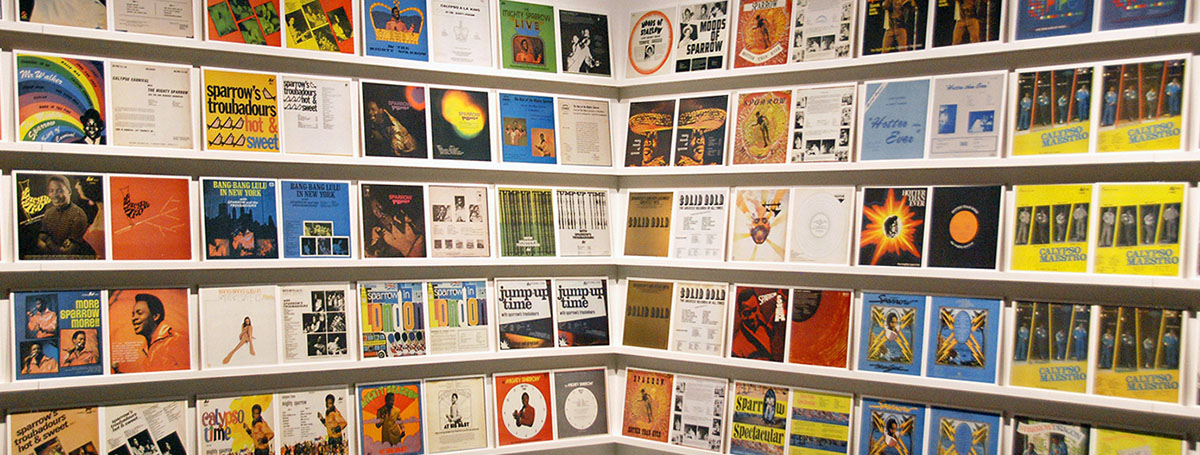Sparrow Come Back Home, Carmel Buckley and Mark Harris’ exhibition at the ICA, examines a reflective side of the display of archive as monument. Taking place in the Fox Reading Room, a space where archival materials are at the heart of each show, the exhibition transforms the gallery into a visual library, a silent record store, and a temporary monument to a living Trinidadian legacy. Since Slinger Francisco, who is better known as the Mighty Sparrow, is still alive today, the travelling temporary monument differentiates itself from, for example, those of Swiss artist Thomas Hirschhorn, who focuses mainly on creating interactive installations as monuments to dead philosophers.
The humble vinyl record becomes elevated into a visual cultural artefact by being cemented into 228 ceramic tiles with decals of front and back images from each record album fired onto them. The colourful replicated LP images are carefully placed into chronological order of the Mighty Sparrow’s career. The decision to leave the colour as shown on the original album speaks of a present archive versus something that no longer exists. The timeline reveals how visual culture and music can and still play an important role in the political expression and historical documentation not only in the world today but specifically of Trinidad and Tobago.
As a reflective installation, it holds a powerful circumstance of the possible unheard and unknown music to viewers who may know nothing of calypso. One of the albums or artefacts that offer a clear representation of the Mighty Sparrow’s political expression is his 1991 Crown Heights Justice, which was made as a plea for peace and tolerance in the wake of the 1991 Crown Heights Riot in New York Cty. The large installation of tiles is also accompanied by an archive of literature, poetry, and photographs relating to calypso and Trinidadian social and political issues, which seems a little excessive considering the complexity of the display of the recreated record album covers. The monument already holds a strong presence within the space and does not need more to captivate the viewer’s imagination and curiosity. However, I do wonder how one can be more mobilised to engage in the idea of the “King of the Calypso World” to understand and appreciate a person who is still alive and performing without undermining him as someone forgotten or deceased.
For both artists, this monument is not only social and historical in nature but also very personal.
For both Buckley and Harris, this monument is not only social/historical in nature but also very personal. Both British artists have visited Trinidad and Harris briefly lived there with his Trinidadian mother. The music is rooted in Harris’ childhood and woven into their artistic and family relationships. For me, the archive should include more hints of this underpinning of a personal family connection indirectly. If not only to widen the value of a broader reflection on cross-cultural influences within the archive displayed as a monument.
With the actual records not physically present, the display acts as a silent record store and visually overwhelms a music aficionado, but it always leaves the viewer wanting to know more about calypsonian music and culture. If anything, the silent record store is a fitting reflection on rumours of the Mighty Sparrow’s death that were proclaimed over and over again and were not true. Hence, at the beginning of every concert, he would sing the Sparrow Dead song. The lyrics to the song include: “Who killed the Sparrow? Nobody knows.”
Before opening in London, Sparrow Come Back Home originated in Key West, Florida and has also been shown in Wilmington, Delaware, as well as in Cincinnati, Ohio within the United States. This is the first archival monument that both Buckley and Harris have created together and has travelled. With each artist having their own very different solo practices, I am intrigued to see if they will create other monuments together in the future just as Hirschhorn has done to comment further on the idea of the monument and its place.
Carmel Buckley and Mark Harris – Sparrow Come Back Home is at the ICA, London until 5th February, 2017

